Old Colorado City
| Old Colorado City | |
|---|---|
|
Old Colorado City Business District | |
 Old Colorado City Location within El Paso County and Colorado Springs (highlighted in red) | |
| Coordinates: 38°50′53″N 104°51′51″W / 38.84806°N 104.86417°WCoordinates: 38°50′53″N 104°51′51″W / 38.84806°N 104.86417°W | |
| Country | United States |
| State | Colorado |
| County | El Paso |
| City | Colorado Springs |
| Incorporated (town) | August 11, 1859[1] |
| Time zone | MST (UTC-7) |
| • Summer (DST) | MDT (UTC-6) |
|
Old Colorado City Historic Commercial District | |
 | |
| Location | N side of Colorado Ave. from 24th St., W to 2611 Colorado Ave., also includes 115 S. 26 St. and 2418 W. Pikes Peak Ave., Colorado Springs, Colorado |
| Area | 8 acres (3.2 ha) |
| Architectural style | Other, Western Victorian |
| NRHP Reference # | 82001018[2] |
| Added to NRHP | November 2, 1982 |
Old Colorado City, formerly Colorado City, is a national historic district in the city of Colorado Springs. Its approximate boundaries are U.S. Highway 24 to the south, 32nd Street to the west, 13th Street to the east and Uintah Street to the north, with the town square restructured as Bancroft Park.[3]
History
Colorado City was founded on May 22, 1859, when the Colorado Town Company, a group mainly from Denver and Auraria, laid claim to two square miles of land. They envisioned that Colorado City would be a major supply hub via Ute Pass for the new gold mines in South Park and the Blue River, where major strikes in the Pike's Peak Gold Rush had recently been made. The name Colorado was chosen (the area was still part of Kansas Territory) because the Blue River mines were supposed to be on the headwaters of the Colorado River. The town prospered in late 1859 and early 1860.[4]
However, by the summer of 1860, newly built roads from Denver to South Park and the Blue River had diverted most of the traffic to and from the mines, and Colorado City commerce instead shifted towards serving the agriculture of Colorado's eastern plains. (Eventually the Denver, South Park and Pacific Railroad would snake from Denver into the South Park.)

Colorado City was the county seat of El Paso County until 1873, when the courthouse moved to Colorado Springs.
By an act passed on November 5, 1861, the first Colorado territorial legislature, meeting in Denver, named Colorado City as the territorial capital. However, Colorado City effectively functioned as the capital for only five days. When the second territorial legislature met at Colorado City on July 7, 1862, in a log cabin that still stands on Colorado Avenue, they found the accommodations so inadequate that they voted to adjourn on July 11 and reconvene in Denver on July 16.[5] Colorado City was never recognized by the Federal government as the territorial capital.
In 1891, major gold strikes were made in Cripple Creek and Victor, on the other side of Pikes Peak from Colorado City, and suddenly supplies were needed for this last major phase of the Colorado Gold Rush and the town's big boom was on. Eventually Colorado City was processing much of the gold ore at the Golden Cycle Mill using Palmer's railroads. Colorado City was the location of a 1903 strike that spread to Cripple Creek and eventually led to the Colorado Labor Wars.
Irving Howbert, one of the founders of Colorado Springs, lived briefly in Old Colorado City prior to 1864.
Colorado City was incorporated into Colorado Springs in 1917.
Overview
Old Colorado City has a shopping district featuring dozens of independently owned art galleries, boutiques, restaurants and special attractions, including Simpich Showcase and Magic Town, at The Michael Garman Museum and Gallery.
See also
References
- ↑ Archived April 27, 2007, at the Wayback Machine.
- ↑ National Park Service (2010-07-09). "National Register Information System". National Register of Historic Places. National Park Service.
- ↑ "Old Colorado City Historical Maps". Archived from the original on 2008-04-06. Retrieved 2008-09-13.
- ↑ Jerome C. Smiley, Semi-Centennial History of Colorado, (Chicago: Lewis, 1913) 267-268.
- ↑ Jerome C. Smiley, Semi-Centennial History of Colorado, (Chicago: Lewis, 1913) 367-369.
External links
 Media related to Old Colorado City at Wikimedia Commons
Media related to Old Colorado City at Wikimedia Commons- Old Colorado City Historical Society
- Things to do in Old Colorado City
